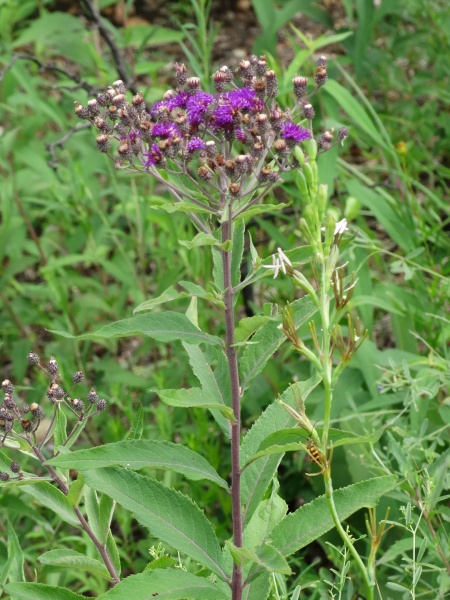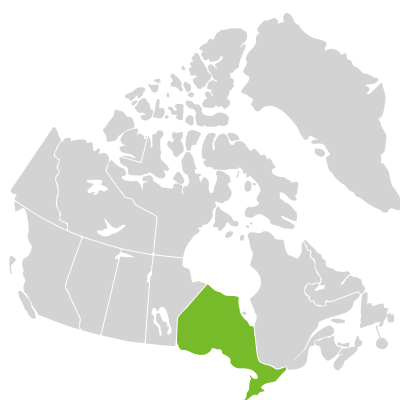 Known to be toxic - Toxic to mammals if ingested and is a skin irritant.
Known to be toxic - Toxic to mammals if ingested and is a skin irritant.

Source: Elaine Wolshock Matthew Fook
Vernonia missurica
Missouri Ironweed
Vernonie du Missouri
Seeds in stock
Available at table Full Sun
Available at table Full Sun
We currently accept seeds for this plant
Bloom Colour: Purple
Bloom Period: Jul - Aug
Max Height: 5.0 feet
Max Width: 3.0 feet (spreads by rhizome)
Light Condition:
 More than 6 hours of direct sun a day
Soil conditions:
More than 6 hours of direct sun a day
Soil conditions:
 Tolerates medium soil condition
Tolerates medium soil condition
 More than 6 hours of direct sun a day
More than 6 hours of direct sun a day
 Tolerates medium soil condition
Tolerates medium soil condition
Lifespan:
Perennial
plants that will that come back year after year
Gardener Experience:
 Does not spread uncontrollably
Does not spread uncontrollably
 Self-seeding
Self-seeding
 Does not spread uncontrollably
Does not spread uncontrollably
 Self-seeding
Self-seeding
Landscape Uses:
No landscape information available.
Ecological Benefits:
 Supports pollinators
Supports pollinators
 Butterfly host
Butterfly host
 Bee host
Bee host
 Supports pollinators
Supports pollinators
 Butterfly host
Butterfly host
 Bee host
Bee host
Tolerates:
 Tolerates limestone conditions
Tolerates limestone conditions
 Tolerates juglone conditions
Tolerates juglone conditions
 Tolerates transplantation
Tolerates transplantation
 Tolerates limestone conditions
Tolerates limestone conditions
 Tolerates juglone conditions
Tolerates juglone conditions
 Tolerates transplantation
Tolerates transplantation
Special Features and Considerations:
 This plant is endangered
This plant is endangered
 This plant is endangered
This plant is endangered
Plant Location
Distribution according to VASCAN

Ephemeral
Native
Introduced
Excluded
Extirpated
Doubtful
Absent
Thrives in Ecozones
- Mixed Wood Plains
Ecological Benefits
Butterflies Supported by Vernonia missurica
- Phragmatobia fuliginosa (Ruby Tiger)
- Vanessa virginiensis (American Lady)
Specialized Bees Supported by Vernonia missurica
- Megachile inimica
- Melissodes denticulatus
- Melissodes subillatus
Plants that grow in similar conditions, that bloom at the same time.
Complementary Plants
- Chamaenerion angustifolium
Fireweed
Épilobe à feuilles étroites - Elymus virginicus
Virginia Wild Rye
Élyme de Virginie - Eupatorium altissimum
Tall Boneset
Eupatoire élevée - Ratibida pinnata
Grey-headed Prairie Coneflower
Ratibida à feuilles pennées
Substitute For Non-Native Plants
- Perovskia Atriplicifolia (Russian Sage)
- Lupinus (Non-Native Lupins)
- Buddleia (Butterfly Bush)
- Delphinium (Delphinium)
- Melilotus albus (Sweet White Clover)
- Lavandula (Lavender)
- Hesperis matronalis (Dame Rocket)
- Liatris (Blazing Star Cultivar)
Sowing Information
Download Seed Envelope Labels (PDF)
- Sowing depth: Sow just below surface
- Sow by February
- Stratification duration: 60 days
- Self-seeding
Harvesting and Seed Sharing
- Harvest start month: October
- Harvesting indicator:
- Seeds have become fluffy and can be easily removed by shaking on gently pulling off from stem
- Harvesting:
- Shake seed head in paper bag
- Seed viability test:
- No test needed before donating
- Packaging measure: 1 rounded 1/4 teaspoon
- Seed storage:
- Air dry in paper bag or open container, for a few days until crisp
- Shake seeds to move them once in a while to prevent molding
- Cultivar: Yes, do not donate unless you know source, and there are no known cultivars in your garden or at proximity
- No harvesting video available at this time.
Toxicity Notes
Toxic to mammals if ingested and is a skin irritant.


 Canadensis
Canadensis
